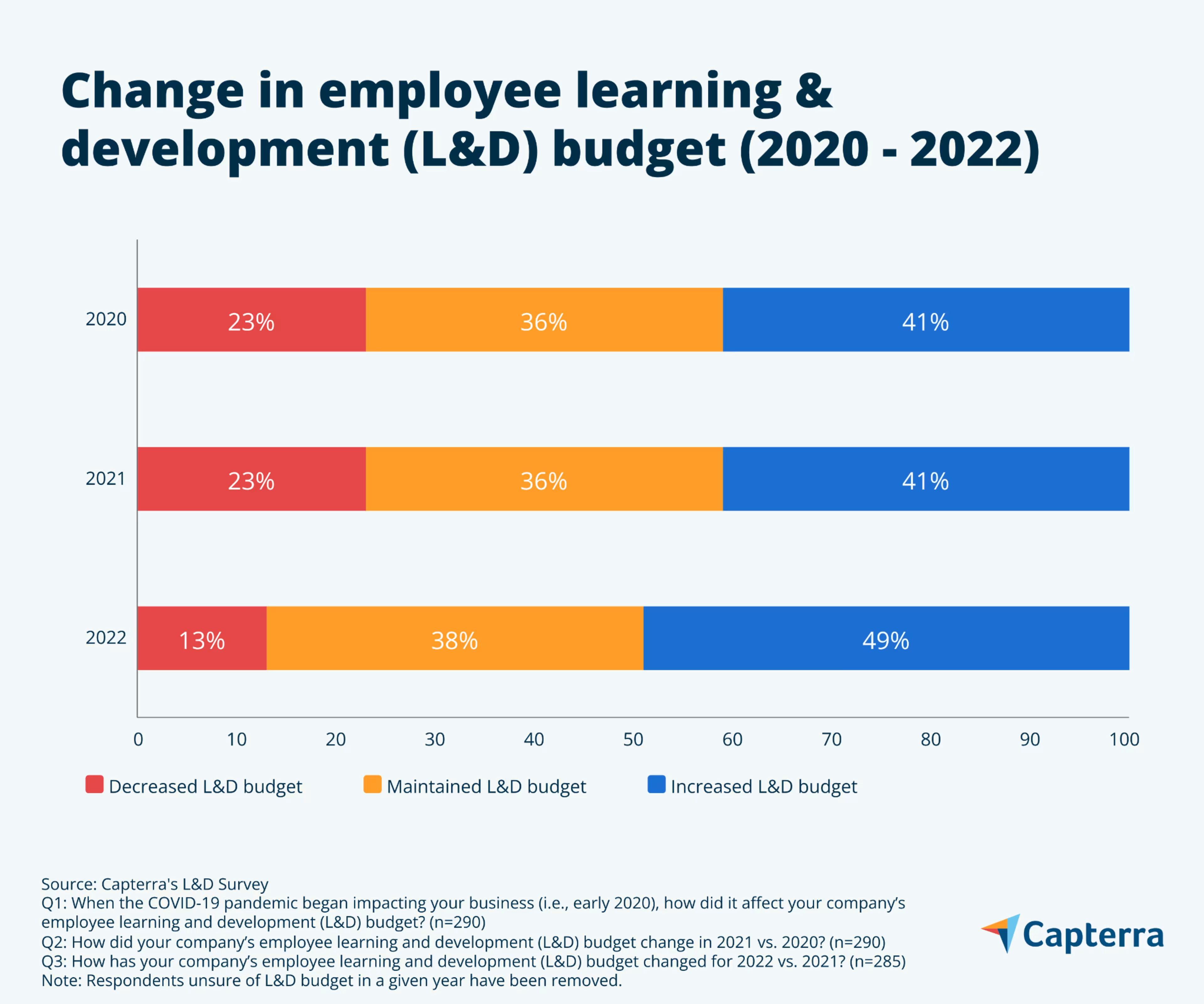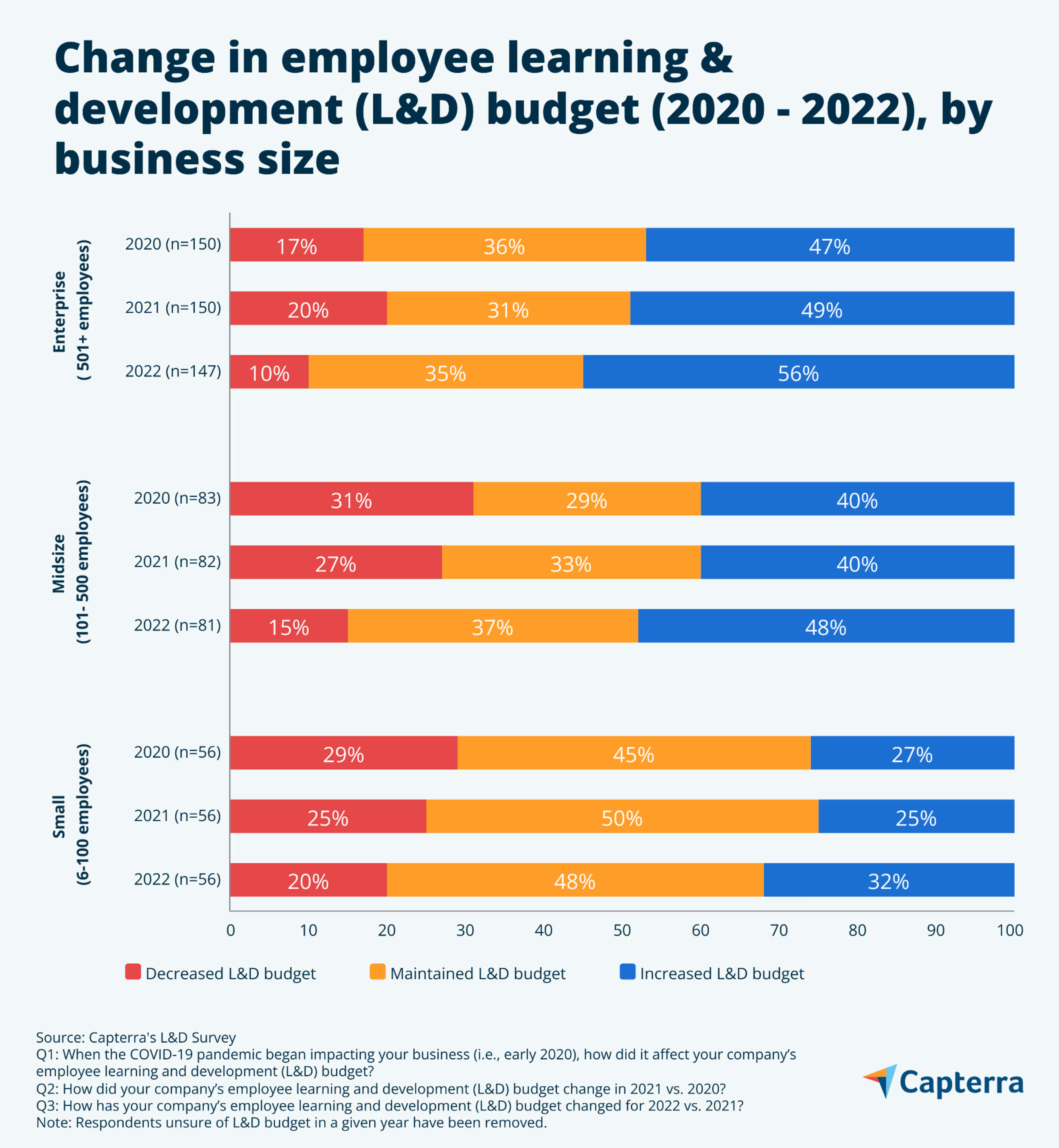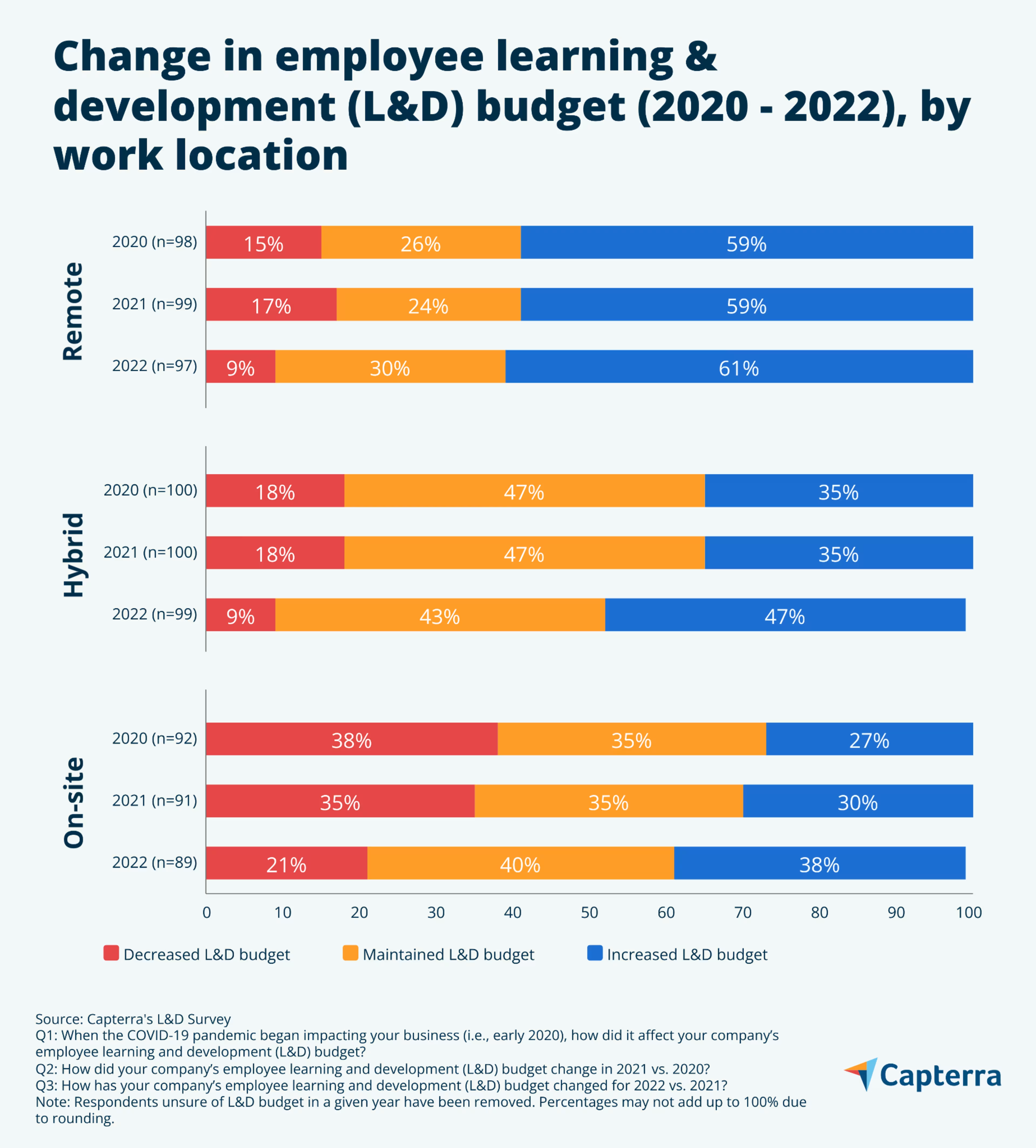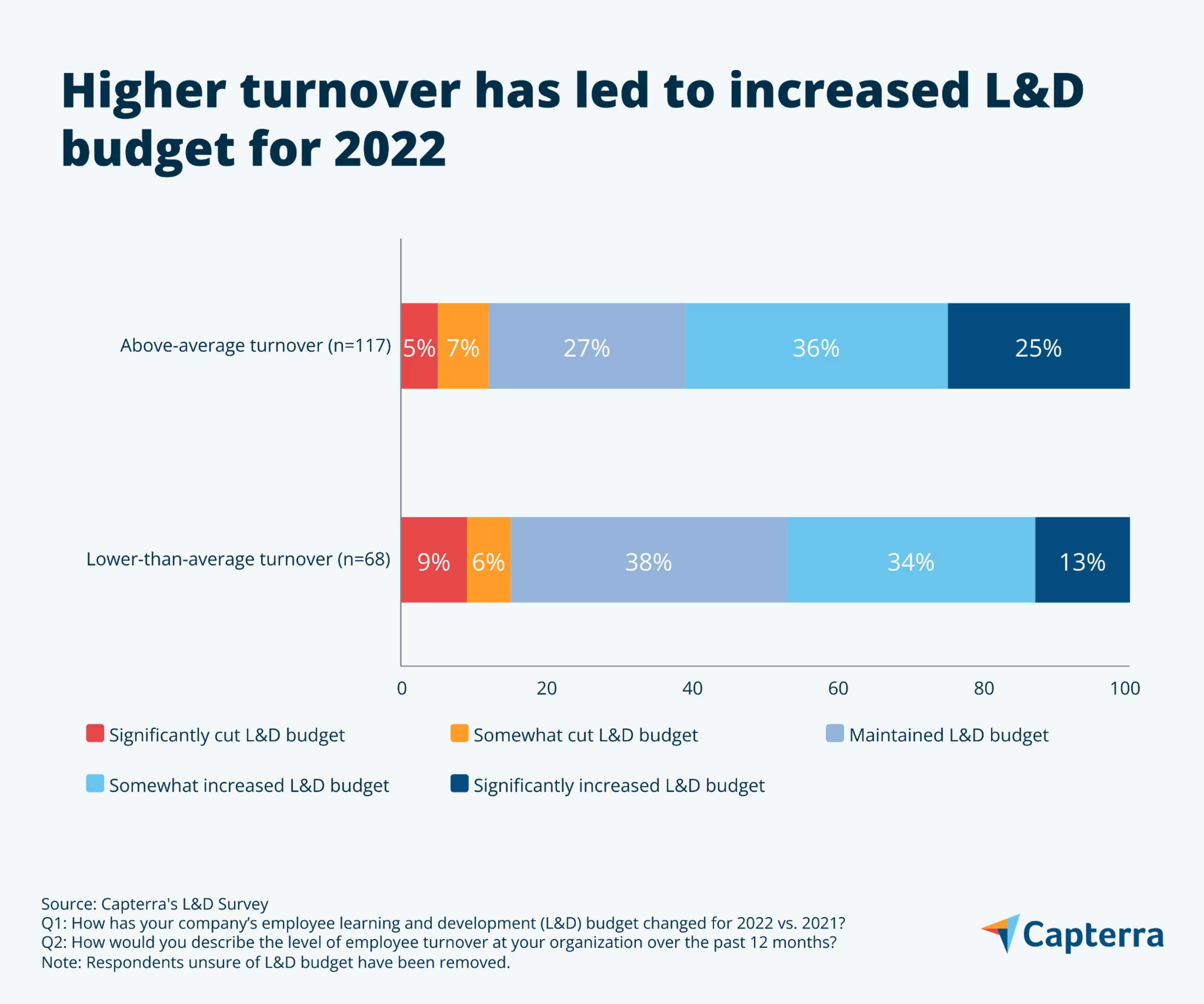The pandemic hasn't slowed learning and development (L&D) investment, according to a new Capterra survey.
Facing a historic knowledge drain, rapid digital transformation, and a seismic shift to remote work, companies are spending big money on upskilling employees.
That’s according to a new Capterra survey of nearly 300 HR leaders, which found that 49% of organizations are increasing their learning and development (L&D) spend in 2022—up from 41% in 2021, a 20% increase YOY.
Below, we’ll reveal the remaining highlights of our L&D survey, and explain why—even with supply chain disruptions and rising inflation continuing to demand attention and dollars—2022 is set to be a watershed year for upskilling training. We’ll also offer advice on how L&D can get the most of their upskilling budget this year.
Key findings
1. Close to half of companies (49%) are increasing their L&D budget in 2022, compared to 41% in 2021.
2. Almost twice as many companies increased their L&D budget than decreased it when the COVID-19 pandemic began.
3. The larger the business, the more likely it is to have increased its L&D budget each of the past three years. Remote businesses have also upped their L&D spend more than hybrid or on-site businesses.
4. Higher turnover stemming from The Great Resignation has prompted companies to significantly increase their L&D budget in 2022.
The pandemic significantly increased L&D spend
Before the COVID-19 pandemic, employee training represented a sizable chunk of HR spend. In 2019, companies spent an average of $1,286 per learner on things like instructors, conferences, training content, and technology to drive effective L&D experiences.
Our survey found that 57% of HR leaders dedicated a "moderate" portion of their HR budget to L&D before the pandemic, while 22% dedicated a "significant" portion.
Given its large cost but lack of necessity to operate, L&D should have been a prime candidate for budget cuts when the COVID-19 pandemic threatened the bottom line. But our results indicate this didn’t often happen. In fact, 41% of HR leaders actually increased their L&D budget in 2020 when their business began to feel COVID-induced effects (vs 23% who decreased it).

This trend hasn’t wavered as the pandemic has dragged on: 41% of HR leaders increased their L&D budget in 2021, and even more (49%) increased their budget for 2022.
Why are businesses increasing their L&D spend during a pandemic? Gartner calls it a “save-to-invest strategy” (full research available to Gartner clients). On the one hand, pandemic-induced shutdowns have allowed businesses to save money on things such as classroom facilities, attending conferences, and the travel and accommodation expenses that come with in-person L&D programs.
On the other hand, many businesses’ virtual L&D systems and content—which have become critical as companies have moved to hybrid or remote working models—have required substantial investments to give employees new skills in the new normal. Companies are using the savings from their in-person L&D initiatives (and then some) to invest in their virtual ones.
Enterprises and remote businesses are leading the employee upskilling charge
Small businesses are lagging on L&D spend
Breaking our results down by business size, we find that enterprises (500+ employees) and midsize businesses (101-500 employees) are increasing their L&D spend more frequently than small businesses (6-100 employees), which have tended to keep their L&D spend the same.

We know that small businesses have been hit particularly hard by COVID-19. At the onset of the pandemic in 2020, 70% of small businesses told us they expected decreased revenue for the year, with 71% expecting to last six months or fewer under current conditions.
Given their struggles, it's not surprising that small businesses haven't put as much spend toward L&D, but this also means they've fallen behind on upskilling their workers. In a 2021 survey, 49% of small-business employees told us they haven’t developed any new work skills so far during the COVID-19 pandemic. Small-business HR leaders understand they have work to do: those increasing their L&D budget have jumped from one in four in 2021 (25%) to almost one in three in 2022 (32%).
The remote learning effect
Our survey results indicate that where current employees work has also had an impact on L&D spend:
Most remote businesses increased their L&D budget each of the past three years.
Hybrid businesses often kept their L&D budget the same in 2020 and 2021, then increased it in 2022.
On-site businesses often decreased their L&D budget in 2020 and 2021, then kept it the same in 2022.

While on-site businesses have only had reasons to cut back L&D spending as in-person training options have dwindled, hybrid and remote businesses have largely had to figure out a whole new way to develop talent (72% of remote/hybrid respondents in our survey transitioned to remote/hybrid work during the pandemic).
As a result, remote businesses are pouring money into L&D and L&D tech in particular—93% of remote HR leaders who are increasing their L&D budget in 2022 plan to spend more on learning and training technology.
As businesses continue to migrate to hybrid and remote work (82% of company leaders plan to let their employees work from home at least some of the time post-pandemic), expect L&D investment to continue to balloon to meet virtual training needs.
What about The Great Resignation?
After a sharp decline at the onset of the pandemic, the number of workers quitting their job has jumped to historic levels over the past year. The Great Resignation—as it’s come to be known—has led to an unexpected drain of important knowledge and skills from organizations.
Our data shows that it has also moved the needle on L&D budgets. We found that 25% of businesses that experienced above-average turnover over the past 12 months are significantly increasing their L&D budget in 2022, compared to only 13% of businesses that experienced lower-than-average turnover.

As well as teaching critical skills to more employees—giving organizations some breathing room should workers with those skills resign—HR leaders believe investing in L&D will be a significant employee retention booster on its own. In our survey, 87% say that their employee learning and development program will be critical to retaining talent in 2022.
3 recommendations for L&D leaders in 2022
Upskilling employees is shaping up to be a huge priority this year. In a recent Gartner survey, 59% of HR leaders named building critical employee skills and competencies as a top priority in 2022 (full research available to Gartner clients).
If you’re in an organization that lacks L&D budget, what can you do to make the most of your upskilling spend this year? Here are our recommendations.
1. Get a free or cheap LMS if you don’t already have one
If any of your employees will be working remotely for the foreseeable future, a learning management system (LMS) will be an important tool to administer virtual learning content and ensure workers can upskill outside of the office.
2. Perform a skills gap analysis
You can’t train every employee on every critical skill at once. Instead, you’ll need to prioritize content and training modules around the new skills that will give you the best value for the cost. To learn where your biggest skill gaps lie, gather your management team and have them do a skills gap analysis of their direct reports. It’s free, and all you need is a spreadsheet.
3. Don’t overlook mentorships
Mentorship programs are the gift that keeps on giving. By pairing workers together in mentor-mentee relationships, you can cheaply democratize knowledge, better engage your employees, and get vital information for how people want to approach their career progression all at once. And yes, there’s free software for this too.
Haven’t landed on a final L&D budget yet? Check out our training budget calculator.
